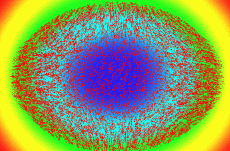ACTS Toolkit Support Debuts on the Web
August 27, 1998

A snapshot of a 2D linear particle accelerator simulation, using a code based on the POOMA Framework. Shown here is the electrostatic potential energy field generated by a set of charged particles as they move through the accelerator. The red arrows indicate the momentum of each particle. As particles move through the various elements of the beamline, they experience accelerations due to forces from the beamline elements and from particle electrostatic interactions. This simulation was performed on a 32-node SGI Origin 2000 computer at Los Alamos National Laboratory, in conjunction with Robert Ryne, Salman Habib, and Ji Qiang from the Computational Accelerator Physics Grand Challenge project.
The ACTS (Advanced Computational Testing and Simulation) Toolkit, a set of DOE-developed software tools that make it easier for programmers to write high-performance scientific applications for parallel computers, now has a dedicated website for user support.
The purpose of ACTS is to accelerate the adoption and use of advanced computing by DOE programs for their mission-critical problems. While DOE has been motivated to develop the tools for its own programs, it also encourages their adoption and use by non-DOE computational efforts. The ACTS project is focusing on establishing a modest collection of useful parallel tools and emphasizing further development that will allow the tools to interoperate. ACTS is funded by the DOE 2000 initiative. The ACTS Toolkit website has been created by NERSC with support from the MICS Division in DOE.
"Our initial role has been to collect all the information about the different tools into a single point of entry," said Brent Milne, a member of NERSC's Future Technologies Group who has been shepherding the project. "Our next step is to work with researchers who are interested in putting the toolkit to work in applications. We strongly encourage any researchers who think they might be able to make use of the ACTS Toolkit to contact us."
Here is some more information on the website created by NERSC:
The ACTS Toolkit differs from other "parallel tools" projects in that it primarily focuses on software used inside an application, instead of software used to develop an application. The tools were mostly developed at DOE labs and universities. ACTS is an umbrella project that has brought the tools together and is funding developers to provide interoperability.
The tools include "traditional" numerical libraries (e.g., linear system and ODE solvers), tools that provide infrastructure to manage some of the complexity of parallel programming (such as the distribution of arrays and communication of boundary information), and tools that provide run-time support ranging from performance analysis to real-time remote visualization.
The ACTS project is a subset of the DOE 2000 project. There are two main components of DOE 2000: The ACTS Toolkit and the National Collaboratory project. The two branches are related in that they both enhance the ability of DOE scientists to solve major scientific and technical problems. Increasingly, these problems involve multiple, complex subproblems that often span several disciplines, requiring scientists from multiple disciplines to work together closely. They also increasingly involve problems of such complexity that scientists are forced to rely heavily on computational investigation. The ACTS project also hopes to improve collaborative computational efforts by providing a uniform basis for software development and by encouraging the writing of modular, reusable code.
The prime beneficiaries of ACTS tools will be developers of parallel scientific applications. Parallel software is inherently more complex than serial software and significantly more expensive to implement. In the past, many smaller projects have been unable to access the benefits of parallel computing because they lack the resources to port their computational codes from serial to parallel implementations. Moreover, as the problems being solved become more complex, the challenges in building parallel programs become even greater. The goal of ACTS is to alleviate this situation, and DOE has made a strong commitment to the success of this project.
For more information, visit the website or send email to: acts-support@nersc.gov.
About NERSC and Berkeley Lab
The National Energy Research Scientific Computing Center (NERSC) is a U.S. Department of Energy Office of Science User Facility that serves as the primary high performance computing center for scientific research sponsored by the Office of Science. Located at Lawrence Berkeley National Laboratory, NERSC serves almost 10,000 scientists at national laboratories and universities researching a wide range of problems in climate, fusion energy, materials science, physics, chemistry, computational biology, and other disciplines. Berkeley Lab is a DOE national laboratory located in Berkeley, California. It conducts unclassified scientific research and is managed by the University of California for the U.S. Department of Energy. »Learn more about computing sciences at Berkeley Lab.







